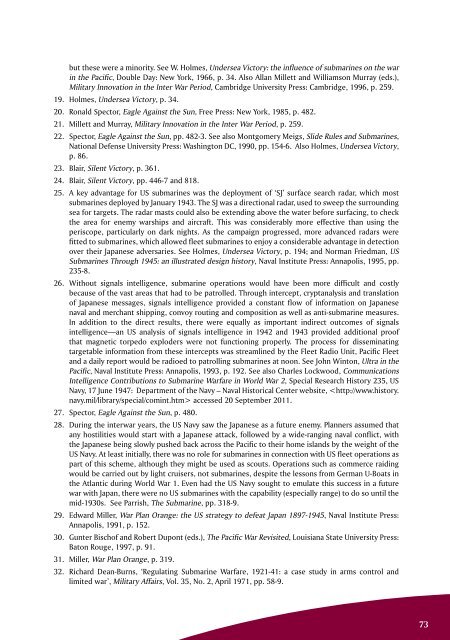190%202013%20Mar_Apr
190%202013%20Mar_Apr
190%202013%20Mar_Apr
Create successful ePaper yourself
Turn your PDF publications into a flip-book with our unique Google optimized e-Paper software.
ut these were a minority. See W. Holmes, Undersea Victory: the influence of submarines on the war<br />
in the Pacific, Double Day: New York, 1966, p. 34. Also Allan Millett and Williamson Murray (eds.),<br />
Military Innovation in the Inter War Period, Cambridge University Press: Cambridge, 1996, p. 259.<br />
19. Holmes, Undersea Victory, p. 34.<br />
20. Ronald Spector, Eagle Against the Sun, Free Press: New York, 1985, p. 482.<br />
21. Millett and Murray, Military Innovation in the Inter War Period, p. 259.<br />
22. Spector, Eagle Against the Sun, pp. 482-3. See also Montgomery Meigs, Slide Rules and Submarines,<br />
National Defense University Press: Washington DC, 1990, pp. 154-6. Also Holmes, Undersea Victory,<br />
p. 86.<br />
23. Blair, Silent Victory, p. 361.<br />
24. Blair, Silent Victory, pp. 446-7 and 818.<br />
25. A key advantage for US submarines was the deployment of ‘SJ’ surface search radar, which most<br />
submarines deployed by January 1943. The SJ was a directional radar, used to sweep the surrounding<br />
sea for targets. The radar masts could also be extending above the water before surfacing, to check<br />
the area for enemy warships and aircraft. This was considerably more effective than using the<br />
periscope, particularly on dark nights. As the campaign progressed, more advanced radars were<br />
fitted to submarines, which allowed fleet submarines to enjoy a considerable advantage in detection<br />
over their Japanese adversaries. See Holmes, Undersea Victory, p. 194; and Norman Friedman, US<br />
Submarines Through 1945: an illustrated design history, Naval Institute Press: Annapolis, 1995, pp.<br />
235-8.<br />
26. Without signals intelligence, submarine operations would have been more difficult and costly<br />
because of the vast areas that had to be patrolled. Through intercept, cryptanalysis and translation<br />
of Japanese messages, signals intelligence provided a constant flow of information on Japanese<br />
naval and merchant shipping, convoy routing and composition as well as anti-submarine measures.<br />
In addition to the direct results, there were equally as important indirect outcomes of signals<br />
intelligence—an US analysis of signals intelligence in 1942 and 1943 provided additional proof<br />
that magnetic torpedo exploders were not functioning properly. The process for disseminating<br />
targetable information from these intercepts was streamlined by the Fleet Radio Unit, Pacific Fleet<br />
and a daily report would be radioed to patrolling submarines at noon. See John Winton, Ultra in the<br />
Pacific, Naval Institute Press: Annapolis, 1993, p. 192. See also Charles Lockwood, Communications<br />
Intelligence Contributions to Submarine Warfare in World War 2, Special Research History 235, US<br />
Navy, 17 June 1947: Department of the Navy – Naval Historical Center website, accessed 20 September 2011.<br />
27. Spector, Eagle Against the Sun, p. 480.<br />
28. During the interwar years, the US Navy saw the Japanese as a future enemy. Planners assumed that<br />
any hostilities would start with a Japanese attack, followed by a wide-ranging naval conflict, with<br />
the Japanese being slowly pushed back across the Pacific to their home islands by the weight of the<br />
US Navy. At least initially, there was no role for submarines in connection with US fleet operations as<br />
part of this scheme, although they might be used as scouts. Operations such as commerce raiding<br />
would be carried out by light cruisers, not submarines, despite the lessons from German U-Boats in<br />
the Atlantic during World War 1. Even had the US Navy sought to emulate this success in a future<br />
war with Japan, there were no US submarines with the capability (especially range) to do so until the<br />
mid-1930s. See Parrish, The Submarine, pp. 318-9.<br />
29. Edward Miller, War Plan Orange: the US strategy to defeat Japan 1897-1945, Naval Institute Press:<br />
Annapolis, 1991, p. 152.<br />
30. Gunter Bischof and Robert Dupont (eds.), The Pacific War Revisited, Louisiana State University Press:<br />
Baton Rouge, 1997, p. 91.<br />
31. Miller, War Plan Orange, p. 319.<br />
32. Richard Dean-Burns, ‘Regulating Submarine Warfare, 1921-41: a case study in arms control and<br />
limited war’, Military Affairs, Vol. 35, No. 2, <strong>Apr</strong>il 1971, pp. 58-9.<br />
73


